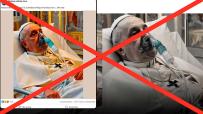
By: Ralph Zapata (Piura), Alicia Tovar (Lambayeque), Claudia Chávez (La Libertad), Magali Estrada (Áncash) y Geraldine Santos (Ucayali)
Last week, in the Peruvian Congress, Víctor Zamora, minister of health, indicated that the medicinal oxygen market in Peru was monopolized. A month before, the Ombudsman had warned the Executive and demanded its intervention in the sale of medicinal oxygen to avoid speculation and hoarding. Such is the case in Iquitos, where only one oxygen tank is worth up to 4,000 soles, in the middle of one the most dramatic episodes of the pandemic in the Amazon area.
“In the context of this global emergency, these abusive market practices have also been registered outside Peru. Spain has been pushing for measures such as a price cap for surgical masks, Chile has implemented price caps for all medical supplies and Colombia has created a list of essential goods with controlled prices to guarantee sufficient supply”, the Ombudsman informed in his report.
Over the past few weeks, the nation-wide increase in prices for this supply called the attention of the Ombudsman. In that context, OjoPúblico analyzed the contracts with the oxygen suppliers of hospitals managed by EsSalud, the Peruvian Ministry of Health and Regional Governments, and concluded that two were the most predominant business clusters in that market: Linde AG, of German origin and, nowadays, with headquarters in the UK, is considered the world’s biggest company in the industrial gas market; and Air Products in the United States, another big company in this sector.

PIURA. Air Products is one of the two clusters that supply Peruvian hospitals with medical oxygen. A few weeks ago, due to the high demand for oxygen by COVID-19 patients, it installed an isotank in Santa Rosa Hospital at Piura.
Photo: Regional Government of Piura
Linde group—with operations in America, Europe, Asia y Africa, shares in The New York Stock Exchange and sales for 29 billion USD—works in Peru through three companies: Praxair Perú, Linde Gas Perú and Tecnogas. In 2019, Linde finally merged with US Praxair INC after a three-year-long procedure to obtain the permits from the regulatory authorities of the United States and the European Union. Currently, this cluster figures in the Forbes ranking of the largest companies in the world.
Between 2008 and 2010, the National Institute for the Defense of Competition and Intellectual Property (Indecopi) opened a case on Praxair Perú (now called Linde) for monopolizing EsSalud’s oxygen market along with two other companies: AGA (now also part of Linde) and Messer Gases del Perú (now Air Products after it was sold in 2018). After such investigations, Indecopi sanctioned them with a fine for 21 million PEN, which was challenged in the Judiciary.
Key players in the public health market
According to the Supervising Agency of the Government Procurement (OSCE), hospitals managed by the Ministry of Health, EsSalud, and local governments in 21 regions bought 385.3 million PEN worth of oxygen from six companies. Among them, three were linked to the German cluster Linde: Praxair Perú (180.7 million PEN), Linde Gas Perú (67.7 million PEN) and Tecnogas (35 million PEN). Another two, to the American cluster Air Products: Indura Perú (30.8 million PEN) and Air Products Perú (57.3 million PEN), which used to be called Messer Gases del Perú. Another one is a local company called Oxyman Comercial (13.8 million PEN).
These contracts, for 385.3 million PEN, add up the sales for adjudications and purchase orders made with the healthcare sector between 2008 and 2020. OjoPúblico established that three of these companies had the most important contracts of these years.
At the top of the list is Praxair Perú (Linde Group), which started its activities in 1996. Its legal address is in Lima and has 265 employees. Since its creation, it has worked in the manufacture of chemical substances. This company was contracted to sell oxygen to hospitals in sixteen regions, as well as to EsSalud hospitals, for more than 180.7 million PEN between 2008 and 2020.

LA LIBERTAD. One of Praxair’s oxygen tanks in a hospital in La Libertad. The company that owns Praxair finished merging with Linde last year.
Photo: Regional Government
The second in the list is Linde Gas Perú (Linde Group), which is engaged in the manufacture of chemical substances. This company started its activities in 1953, has its legal address in Callao, and has over 90 employees. Furthermore, it is the owner of oxygen production and packing plants in Lima, Arequipa, Huancayo, and in almost all of northern Peru (Piura, Lambayeque, La Libertad, and Ancash). Linde Gas Perú sold oxygen to hospitals in 14 regions and to EsSalud for 67.7 million PEN between 2008 and 2020.
The third in the list is Air Products Perú (Air Products group). It was established in 1998 in Lima with the name of Messer Gases del Perú and has 213 employees. Between 2008 and 2020, the company sold oxygen to hospitals in twelve regions and to EsSalud, for 57.3 million PEN. In 2018, Air Products Perú acquired definitely Messer Gases del Perú and incorporated it to its commercial group, which was already operating in Lima with Indura.
Indecopi’s sanction for market allocation
In 2008, Indecopi started an administrative sanction process against Praxair Perú and AGA (both now belong to Linde group), and Messer Gases del Perú SA (acquired by Air Products Perú in 2018). The companies were accused of competition-restricting practices in the form of market allocation during the selection procedures conducted by EsSalud to purchase liquid and gas medical oxygen nationwide between January 1999 and June 2004.
According to Indecopi's resolution, these three companies supplied EsSalud's oxygen demand almost exclusively during that period. The investigation concluded in 2010, when the regulatory body found these companies liable and sanctioned them with 21 million PEN. However, Indecopi finally confirmed the decision in 2013.
That year, Indecopi's Division with Jurisdiction over Defense of Competition definitely concluded that the three companies allocated the oxygen sales market to EsSalud as follows: Praxair Perú, Lima and the southern area of Peru; AGA, the northern area; and Messer Gases del Perú, the central area.
INDECOPI'S INVESTIGATION FOUND THREE COMPANIES LIABLE. PRAXAIR PERÚ WAS SANCTIONED WITH 21 MILLION PEN
Displeased with Indecopi's decision, oxygen companies took the case to courts. The Judiciary passed sentence at the court of first instance in 2015, and at the court of appeals, in 2017. To avoid paying the fine, companies lodged an appeal before the Supreme Court of Peru, which made an oral report last year. Since then, the case remains without a sentence.
The increase of oxygen prices on the northern coast
In early April, Peru-Korea Friendship Hospital Santa Rosa II-2 at Piura, reserved for COVID-19 cases, ran out of oxygen. Signs were posted in the hospital windows informing that the oxygen was unavailable/they had run out of supplies. Many patients were even told that they would not be admitted unless they provided their own oxygen cylinder.
However, Peruvian hospitals, as happens with Santa Rosa Hospital in Piura, negotiate contracts for months with oxygen suppliers. In June 2019, this hospital bought 46,720m3 of medical oxygen gas for 5.30 PEN per m3. In total, they paid 247,000 PEN to Air Products Perú. This supply was covered until February of this year.
Besides, Santa Rosa also bought an isotank with a capacity of 18,000m3 from the same company, since one of the reasons of the oxygen shortage was the lack of containers to store it, according to the health authorities. The isotank cost 580,000 PEN and is already installed and operational at the hospital.
THIS YEAR, PIURA REGIONAL GOVERNMENT REPORTED A PURCHASE OF OXYGEN FROM AIR PRODUCTS PERÚ AT 6.60 PEN PER CUBIC METER, 1.30 PEN MORE THAN THE AMOUNT PAID IN FEBRUARY.
Additionally, this year, sources from Piura Regional Government reported a purchase of oxygen from Air Products Perú at 6.60 PEN per cubic meter, 1.30 PEN more than the amount paid this year in February.
In April 2019, Air Products Perú was also contracted by a simplified acquisition procedure to provide medical oxygen to Sullana Support Hospital II-2. This time, 19,800m3 of oxygen were purchased at 6.35 PEN per m3, altogether, more than 125,000 PEN were paid.
Another oxygen provider of Sullana Hospital and other hospitals in the north of the country is Oxyman Comercial SAC. In 2019, the company sold such supply at 6.14 PEN per m3 to Sullana Hospital. In total, 4,500m3 were bought for a total amount of 27,630 PEN.

PIURA. The Peruvian company Oxyman supplies oxygen to hospitals in Piura and Sullana. During the pandemic, an increase in the price has been identified in the sales to the health sector.
Photo: Regional Government of Piura
Iván Calderón, until recently director of the Sullana Hospital, informed OjoPúblico that, in March 2020, Oxyman Comercial was asked again to supply 45,000m3 of oxygen. Its pricing was 7.50 PEN per m3, which was 1.36 PEN more expensive than the price paid last year.
"The price of supplies has not increased. Why did they sell us the oxygen for a higher price? It is an oligopoly. Few companies are in this business," the doctor said.
The problem, according to Calderón, is that Oxyman promised to supply 1,000m3 of oxygen per day to Sullana Hospital, but it only delivers 700 to 800m3. The doctor stated: "That is why we are unable to establish the new COVID-19 unit ICU, which is operating in the city's stadium. We have complained, but they ignore us. However, they are selling oxygen to private individuals, which we think is a lack of respect.”
THE SALES OF OXYGEN ARE AN OLIGOPOLY. FEW COMPANIES ARE IN THIS BUSINESS,” EXPRESSED THE FORMER DIRECTOR OF SULLANA HOSPITAL
In Tumbes, there is also a significant increase in the price of oxygen per m3. During the COVID-19 emergency in April of this year, Air Products Perú sold 4,000m3 of oxygen at 10.79 PEN per m3, to the Regional Hospital II-2 José Mendoza Olavarría Jamo. In other words, the company sold oxygen to this hospital for 4.19 PEN more than what was offered to Santa Rosa Hospital at Piura. In total, the Tumbes Hospital paid 43,000 PEN.
Two years earlier, in 2018, Air Products Perú sold medical oxygen to the same hospital at Tumbes at 9.06 PEN per m3.
OjoPúblico spoke with the director of the Tumbes Regional Hospital, Jorge Banda, who stated that he had taken office less than a month ago. “This price difference must be addressed by the head of logistics. In this pandemic everything is scarce and even a surcharge is being paid”, he indicated.

LORETO. Long queues/lines of people trying to fill their oxygen cylinders have become usual in the last weeks at Iquitos, the Amazonian capital that has been
affected the most by coronavirus.
Photo: Ginebra Peña / OjoPúblico
At La Libertad, the price increase of such product is also evident. In April, the Regional Government contracted Praxair Perú for a 3,200m3 supply of oxygen at 10.62 PEN per m3. The Chepén Support Hospital paid a total amount of 33,984 PEN. This company also was awarded oxygen sale procedures from the Luis Pinillos Ganoza Regional Northern Institute of Neoplastic Diseases and from the Health Assistance Network of this region.
In 2018, the Chepén Support Hospital contracted Oxyman Comercial for a 3,500m3 supply of oxygen at 7.90 PEN per m3. In other words, at 2.72 PEN less than what was charged this year by Praxair. The health institution paid a total amount of 27,650 PEN.
AT LA LIBERTAD, THE PRICE INCREASE OF OXIGEN IS ALSO EVIDENT. IN APRIL, THE REGIONAL GOVERNMENT CONTRACTED PRAXAIR PERÚ.
La Libertad regional governor, Manuel Llempén, told OjoPúblico that Praxair will supply an additional amount of 10,000m3 of oxygen to the Chepén Hospital between June and July. "The purchase order for a supply that has been continuous in the city of Chepén is in full operation. In addition, a purchase order has also been generated from June 1 to July 31. We are making purchases in advance," he said.
The high prices of oxygen, which affect several regions of the north, are also a concern for Ancash. Although Eleazar Guzmán, Nuevo Chimbote Regional Hospital, spent 14,858 PEN on oxygen in April, to cover their needs for 2020; the high demand for this supply will force the authorities to make new purchases.
Since 2013, this hospital has been purchasing oxygen from Air Products Perú. The company sold this supply, between 2011 and 2020, to three hospitals in Ancash, invoicing more than 5 million PEN.
As for the Victor Ramos Guardia Hospital at Huaraz, a public tender was launched in April to buy 120,000m3 of oxygen for 2020, at a reference value of 696,000 PEN that is, at 5.8 PEN per m3, but as a supplier did not submit its economic offer and that Air Products Perú bid above the allowed value, the process was not awarded on two occasions.
THE HIGH OXYGEN PRICES AFFECTED HOSPITALS IN THE REGIONS MOST AFFECTED BY THE COVID-19 OUTBREAK.

ANCASH. In the hospitals of the north coast, such as the Ancash Regional Hospital, the demand for oxygen has increased for patients with COVID 19.
Photo: Reynaldo Manrique
Carlos Loarte, director of the hospital, told OjoPúblico that there is no shortage of this supply and that it might not be any in the short term, since the Ancash Regional Government is working on a project to acquire an oxygen production plant; furthermore, Antamina mining company offered them another plant.
Meanwhile, Praxair Perú is in charge of supplying oxygen to EsSalud Hospital III at Chimbote, but has also contracted with the Lambayeque Regional Hospital. Óscar Tineo Carrasco, director of the latter, told us that the plant that supplies them with oxygen may run out of it in four months. However, the contract with the company will be in force for one year.
"It's true; consumption (of oxygen) can be brought forward because patients are increasing. Before, we used to consume an average of 16,000m3, (of oxygen) and now, it is 45,000," he stated. There are several informal businesses that offer oxygen at exceedingly expensive prices in the region. In fact, a 10m3 oxygen cylinder can cost up to 3,300 PEN, as verified by OjoPúblico.
Family-owned and local businesses sell oxygen in the Amazon
In Loreto there are three family businesses that supply Iquitos Support Hospital, the Regional Hospital and the Social Security: Oxígeno Iquitos SRL, whose representative is María Chung Montoya de Sato; Oxígeno TAO EIRL and The Amazon Oxygen SAC, both represented by Elsa Sato Arévalo, whose children, Elsa and Diego Valera Sato, are shareholders of the latter.
Oxígeno Iquitos, the largest company in Loreto of this sector, has Chung Montoya de Sato as its legal representative. She is the wife of the late businessman Ángel Sato, father of Elsa Sato Arévalo, who currently owns The Amazon Oxygen SAC and Oxígeno TAO. In Loreto, Oxígeno Iquitos contracted with the Social Security and the Regional Government hospitals for more than 4.2 million PEN between 2008 and 2019.
Meanwhile, in Loreto, The Amazon Oxygen SAC had contracts for 2.3 million PEN between 2010 and 2017. The company sold oxygen to Social Security and the Iquitos Support Hospital and the Iquitos Regional Hospital at Loreto. On the other hand, Oxígeno Tao EIRL contracted with Social Security for 1.4 million PEN between 2016 and 2018.

LORETO. Iquitos suffered one of the worst COVID-19 outbreaks in the Amazon region of Peru. In the last few weeks, patients crowded the hospital rooms taking with them their oxygen cylinders.
Photo: Ginebra Peña / OjoPüblico
Oxygen is key to treat the disease. The lack of rapid tests to detect COVID-19 has shifted to the background, prioritizing the acquisition of oxygen cylinders to monitor patients with difficulty breathing, explained to this newspaper Carlos Calampa, the director of Loreto Regional Health Department,.
"Due to the high demand of patients, we need at least 1,000 oxygen cylinders. Each patient uses two: one oxygen supply for breathing and the other one as a contingency measure, but we barely have 200 cylinders. What can we do? We cannot take oxygen from one patient to give it to another,” said Calampa.
UCAYALI: THE INCREASE ON CUBIC METER PRICES THAT OXÍGENO LORETO OFFERS WAS ALSO DETECTED
In Ucayali there has also been a price increase of cubic meters of oxygen offered by Oxígeno Loreto. In 2019, it sold 33,900m3 of oxygen to the Pucallpa Regional Hospital at the price of 11.48 PEN per m3. However, in March of this year it did so at 12.48 PEN the m3, that is to say, 1 PEN more. In total, the regional authorities bought 32,000m3 for a value of 399,360 PEN.
Nevertheless, in another hospital, exclusive for COVID-19, the Yarinacocha Amazonian Hospital, the price increased in almost 2 PEN. This year this hospital bought 24,300m3, also from the Oxígeno Loreto, for the price of 12.48 PEN per m3. In total, the authorities paid 303,264 PEN. In 2019, the price of m3 cost 10.50 PEN.

UCAYALI. In Pucallpa, Oxígeno Loreto increased the price of a cubic meter of oxygen in almost 2 PEN compared to the last year, according to the contracts revised by OjoPúblico.
Photo: Gino Rossi
Concerning this issue, the director of the Yarinacocha Amazonian Hospital, Henry Zamora, told OjoPúblico that the unit of this essential medical supply had to be bought for 12.48 PEN from Oxígeno Loreto because "it was the only supplier they had" in the region of Ucayali. “We could not refuse the price increase because not buying them meant not supplying oxygen for patients,” said Zamora.
There was also a price increase in the neighboring San Martín. Oxígeno Alfa Medical increased in 2.50 PEN the price of the m3 in a year. In July 2019, they won the contract award to provide 14,400m3 of oxygen to the Tarapoto II-2 Hospital. The price for each m3 was 18 PEN, so this hospital paid a total of 259,000 PEN for this supply. However, last April, once in the pandemic, it sold 28.800m3 of oxygen for the price of 20.50 PEN a m3. In total, the hospital paid 590,000 PEN.
What oxygen suppliers said
OjoPúblico contacted Praxair Perú to schedule an interview, but it was not possible. This company said that “their pricing policy is determined by different variables and technical conditions of the oxygen supply industry”. We asked them some questions about the Indecopi sanction that was imposed to it together with other two companies, as well as the price increase. However, the company just sent a press release without answering any question.
We also contacted Air Products to schedule an interview, but we did not receive any answer at the press/publication deadline. The same happened with Linde Gas Perú. Regarding the supplier companies of the Amazonian hospitals, as Oxígeno Loreto, Oxígeno Iquitos and Oxígeno Alfa Medical, OjoPúblico tried to contact their representatives several times, but failed to receive any answer.














 Tienes reportajes guardados
Tienes reportajes guardados




